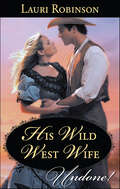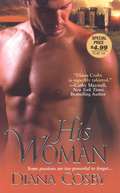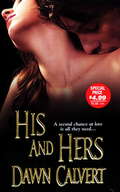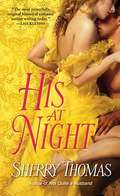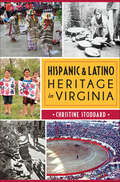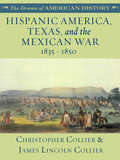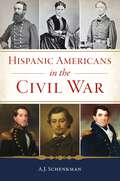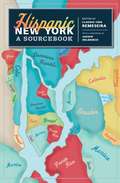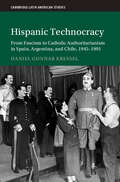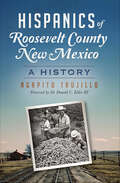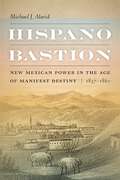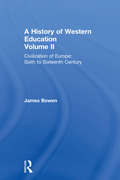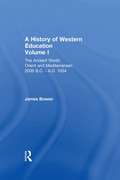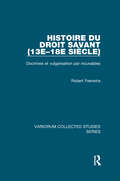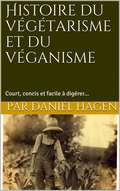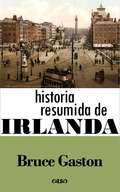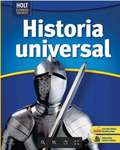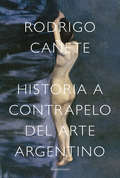- Table View
- List View
His Wild West Wife (Undone!)
by Lauri RobinsonCentral Kansas, 1883Chicago lawyer Blake Barlow has tracked his runaway wife all the way to the middle of nowhere. If she wants a divorce, he'll grant her one-as soon as she tells him why she left.Clara Johnson is angry. Blake betrayed her mere weeks after exchanging vows-but when he rides up to her family farm, it's to get her signature, not to beg for forgiveness.Clara and Blake agree their brief marriage was an impulsive mistake-but that doesn't stop the passion between them from flaring as hot as ever...
His Woman (MacGruder Brothers #2)
by Diana CosbyA Scottish highlander must rescue the woman who broke his heart in this historical romance for fans of Diana Gabaldon. Trusting Her Was Unthinkable…Lady Isabel Adair is the last woman Sir Duncan MacGruder wants to see again, much less be obliged to save. Three years ago, Isabel broke their engagement to become the Earl of Frasyer&’s mistress, shattering Duncan&’s heart and hopes in one painful blow. But Duncan&’s promise to Isabel's dying brother compels him to rescue her from those determined to bring down Scottish rebel Sir William Wallace.Resisting Her Was Impossible…Betraying the man she loved was the only way for Isabel to save her father, but every moment she spends with Duncan reminds her just how much she sacrificed. No one could blame him for despising her, yet Duncan&’s misgivings cannot withstand a desire that has grown wilder with time. Now, on a perilous journey through Scotland, two wary lovers must confront both the enemies who will stop at nothing to hunt them down, and the secret legacy that threatens their passion and their lives…&“Former lovers find each other again in book two of Cosby&’s Scottish trilogy. She deftly combines historical accuracy, well-rounded characters and continuous action in this sweeping romance, which should keep readers engaged until the last page.&”—Romantic Times
His and Hers
by Dawn CalvertTell Me What You Want. . .Sitting in her favorite coffee shop, Jane Ellingson realizes a frappucino can't fix a broken heart. She used to have a cool job, a best friend, and a fiancé--and she lost them all in one really bad day. Hey, can she have a do-over? How about a whole new life?. . .What You Really, Really Want. But Jane is about to get a second chance when she finds a stone that comes with a wish. With nothing to lose, Jane figures she'll go for it--and suddenly she finds herself in Victorian England, meeting the dashing Curran Dempsey. Before long she's smitten--and completely unable to stay in her corset. In fact, she feels just like the heroine in a romance novel, madly in love with a man who's too fabulous to be real. . .and too sexy to give up.
His at Night
by Sherry ThomasFrom the most powerfully original historical romance author writing today (Lisa Kleypas) comes a lush, seductive new romance about a lord and lady who seem a perfect match--until they discover each other's secrets. Original.
Hispanic & Latino Heritage in Virginia (American Heritage)
by Christine StoddardLong before the adventures of John Rolfe and Pocahontas, Spanish ships reached Virginia's shore. In the centuries that followed, Hispanics and Latinos settled in Virginia to seek new opportunities away from home. The 1980s saw the beginnings of el Nuevo Sur, or the New South, as Virginia's Latin American population surged. Since then, the now-defunct Virginia Center for Latin American Art briefly showcased Virginia's Latino and Hispanic evolving arts heritage. Restaurants like Pollo Campero and La Tasca have joined the local culinary scene, and schools and churches have forged plans for their changing communities. Join author Christine Stoddard as she traces the vibrant history and culture of Hispanics and Latinos in Virginia.
Hispanic America, Texas, and the Mexican War: 1835 - 1850
by James Lincoln Collier Christopher CollierHistory is dramatic -- and the renowned, award-winning authors Christopher Collier and James Lincoln Collier demonstrate this in a compelling series aimed at young readers. Covering American history from the founding of Jamestown through present day, these volumes explore far beyond the dates and events of a historical chronicle to present a moving illumination of the ideas, opinions, attitudes and tribulations that led to the birth of this great nation. Hispanic America, Texas, and the Mexican War examines the history of the southwestern area of the United States. Topics covered include the Spanish presence in the area, manifest destiny, and the American attitude toward the expansion of slavery. The text is enhanced with images of art & artifacts, maps, and photographs of historic landmarks.
Hispanic Americans in the Civil War (Civil War Series)
by A. J. SchenkmanForgotten Fighters and Unknown ExploitsMore than twenty thousand Hispanic Americans served in the Civil War. When Cuban-born Loreta Janeta Velázquez’s husband would not allow her to join him on the battlefield, she assumed the role of First Lieutenant Harry T. Buford to be near him. Philip Bazaar, born in Chile, was awarded the Medal of Honor for his courageous exploits during the assault of Fort Fisher. The spying efforts of Floridian Maria Dolores “Lola” Sánchez and her two sisters led to a Union defeat at the Battle of Horse Landing. Union Admiral David Farragut, of Spanish descent, was not only the navy’s first admiral, but he was also the man who uttered the famous phrase, “Damn the torpedoes, full speed ahead.” Delving into the lives of these figures and more, A.J. Schenkman uncovers this often-overlooked aspect of Civil War history.
Hispanic New York: A Sourcebook
by Remeseira Claudio Iván ed. Foreword by Andrew DelbancoOver the past few decades, a wave of immigration has turned New York into a microcosm of the Americas and enhanced its role as the crossroads of the English- and Spanish-speaking worlds. Yet far from being an alien group within a "mainstream" and supposedly pure "Anglo" America, people referred to as Hispanics or Latinos have been part and parcel of New York since the beginning of the city's history. They represent what Walt Whitman once celebrated as "the Spanish element of our nationality."Hispanic New York is the first anthology to offer a comprehensive view of this multifaceted heritage. Combining familiar materials with other selections that are either out of print or not easily accessible, Claudio Iván Remeseira makes a compelling case for New York as a paradigm of the country's Latinoization. His anthology mixes primary sources with scholarly and journalistic essays on history, demography, racial and ethnic studies, music, art history, literature, linguistics, and religion, and the authors range from historical figures, such as José Martí, Bernardo Vega, or Whitman himself, to contemporary writers, such as Paul Berman, Ed Morales, Virginia Sánchez Korrol, Roberto Suro, and Ana Celia Zentella. This unique volume treats the reader to both the New York and the American experience, as reflected and transformed by its Hispanic and Latino components.
Hispanic New York: A Sourcebook
by Claudio Iván RemeseiraOver the past few decades, a wave of immigration has turned New York into a microcosm of the Americas and enhanced its role as the crossroads of the English- and Spanish-speaking worlds. Yet far from being an alien group within a "mainstream" and supposedly pure "Anglo" America, people referred to as Hispanics or Latinos have been part and parcel of New York since the beginning of the city's history. They represent what Walt Whitman once celebrated as "the Spanish element of our nationality. " Hispanic New Yorkis the first anthology to offer a comprehensive view of this multifaceted heritage. Combining familiar materials with other selections that are either out of print or not easily accessible, Claudio Iván Remeseira makes a compelling case for New York as a paradigm of the country's Latinoization. His anthology mixes primary sources with scholarly and journalistic essays on history, demography, racial and ethnic studies, music, art history, literature, linguistics, and religion, and the authors range from historical figures, such as José Martí, Bernardo Vega, or Whitman himself, to contemporary writers, such as Paul Berman, Ed Morales, Virginia Sánchez Korrol, Roberto Suro, and Ana Celia Zentella. This unique volume treats the reader to both the New York and the American experience, as reflected and transformed by its Hispanic and Latino components.
Hispanic Representation in the Department of Defense Civilian Workforce: Trend and Barrier Analysis
by Nelson Lim Kimberly Curry Hall Abigail Haddad Miriam Matthews Bruce R. Orvis ZavislanHispanics are less represented in the U.S. Department of Defense (DoD) civilian workforce than in the federal civilian workforce and the civilian labor force. This report assesses what factors might account for Hispanic underrepresentation in DoD. It includes assessments of trends in Hispanic employment and analyses of job applicant data. It also presents findings from interviews with representatives of DoD and of Hispanic-serving institutions.
Hispanic Technocracy: From Fascism to Catholic Authoritarianism in Spain, Argentina, and Chile, 1945–1991 (Cambridge Latin American Studies)
by Daniel Gunnar KresselHispanic Technocracy explores the emergence, zenith, and demise of a distinctive post-fascist school of thought that materialized as state ideology during the Cold War in three military regimes: Francisco Franco's Spain (1939–1975), Juan Carlos Onganía's Argentina (1966–1973), and Augusto Pinochet's Chile (1973–1988). In this intellectual and cultural history, Daniel Gunnar Kressel examines how Francoist Spain replaced its fascist ideology with an early neoliberal economic model. With the Catholic society Opus Dei at its helm amid its 'economic miracle' of the 1960s, it fostered a modernity that was 'European in the means' and 'Hispanic in the ends.' Kressel illuminates how a transatlantic network of ideologues championed this model in Latin America as an authoritarian state model that was better suited to their modernization process. In turn, he illustrates how Argentine and Chilean ideologues adapted the Francoist ideological toolkit to their political circumstances, thereby transcending the original model.
Hispanics of Roosevelt County, New Mexico: A History (American Heritage)
by Agapito TrujilloIn 1942, several Hispanic families left drought-devastated Encino and headed for the small, peanut-farming town of Portales in Roosevelt County, New Mexico. Among them was the Trujillo family, including five-year-old Agapito, who later became the county's first Hispanic law enforcement officer. The new arrivals did not feel welcome in Portales, which was almost entirely Anglo and a rumored "sundown" town. However, determined to put down roots and take advantage of economic opportunities, they eventually thrived. Agapito Trujillo tells the story of his family's migration to Roosevelt County alongside the struggles and triumphs of the Hispanic community with candor, grace and an obvious love for his heritage and neighbors.
Hispano Bastion: New Mexican Power in the Age of Manifest Destiny, 1837-1860
by Michael J. AlaridIn this groundbreaking study, historian Michael J. Alarid examines New Mexico&’s transition from Spanish to Mexican to US control during the nineteenth century and illuminates how emerging class differences played a crucial role in the regime change. After Mexico won independence from Spain in 1821, trade between Mexico and the United States attracted wealthy Hispanos into a new market economy and increased trade along El Camino Real, turning it into a burgeoning exchange route. As landowning Hispanos benefited from the Santa Fe trade, traditional relationships between wealthy and poor Nuevomexicanos—whom Alarid calls patrónes and vecinos—started to shift. Far from being displaced by US colonialism, wealthy Nuevomexicanos often worked in concert with new American officials after US troops marched into New Mexico in 1846, and in the process, Alarid argues, the patrónes abandoned their customary obligations to vecinos, who were now evolving into a working class. Ultimately wealthy Nuevomexicanos, the book argues, succeeded in preserving New Mexico as a Hispano bastion, but they did so at the expense of poor vecinos.
Hist West Educ: Vol. Iii, The Modern West, Europe And The New World
by James BowenFirst Published in 2003. Routledge is an imprint of Taylor & Francis, an informa company.
Hist West Educ: Vol. Iii, The Modern West, Europe And The New World (Routledge Library Editions Ser.)
by James BowenFirst Published in 2003. Routledge is an imprint of Taylor & Francis, an informa company.
Hist West Educ:Ancient World V 1
by James BowenFirst Published in 2003. Routledge is an imprint of Taylor & Francis, an informa company.
Histoire du droit savant (13e–18e siècle): Doctrines et vulgarisation par incunables
by Robert FeenstraThis third selection of articles by Robert Feenstra complements the two previously published, continuing his studies of doctrines of private law and of texts related to university teaching from the 13th century into the early modern period. In the section on private law, some pieces deal with the Middle Ages, while others focus on Hugo Grotius. Property is again an important topic, but this time joined by legal personality (foundations) and negligence (vicarious liability included). The studies on the history of texts are mainly concerned with works dating from the 14th and 15th centuries. One is devoted to a little-known civil law teacher at the University of Orléans and his commentary on a part of the Digest. The four others deal with treatises belonging to the so-called 'vulgarisation' of the 'droit savant' (medieval Roman and Canon law); most of these include important contributions to the history of early printing (incunabula and post-incunabula). Cette troisième sélection d'articles de Robert Feenstra complète les deux précédentes; elle constitue la suite de ses études sur les doctrines de droit privé et sur des textes se rapportant à l'enseignement universitaire du XIIIe jusqu'au XVIIIe siècle. Dans la section consacrée au droit privé, quelques articles s'occupent en premier lieu du moyen âge, d'autres focalisent sur Hugo Grotius. La propriété est de nouveau un sujet important, mais elle se trouve en compagnie de la personnalité juridique (notamment par rapport aux fondations) et de la responsabilité civile (y compris la responsabilité du fait d'autrui). Les études sur l'histoire des textes concernent surtout quelques ouvrages du XIVe et du XVe siècle. La première est consacrée à un professeur de droit civil peu connu de l'université d'Orléans et à son commentaire sur l'une des trois parties du Digeste. Les quatre autres s'occupent de traités appartenant à la "vulgarisation" du droit savant (droit romain et droit canonique au moye
Histoire du végétarisme et du véganisme: Court, concis et facile à digérer...
by Daniel HagenBrève histoire du végétarisme et du véganisme. L'élevage commercial et industrialisé est l'une des principales causes du changement climatique. Notre rapport à la consommation de viande est devenu complètement incontrôlable. La viande en tant qu'aliment est devenue un produit de dumping dans notre soi-disant Premier Monde. La production moderne de viande est au respect de la nourriture et des êtres vivants ce que l’insulte est à un salut. Heureusement, une réflexion est en train de naître, lentement mais sûrement. De plus en plus de gens se nourrissent de plantes, de fruits, de noix, de légumineuses et de nombreux autres délices que nous offre la flore de notre terre. Le régime végan ou végétalien (ou au moins la réduction drastique de sa consommation de viande et de poisson) est plus à la mode que jamais ... et en passe de devenir la norme. Ce sont surtout les jeunes générations d'aujourd'hui qui prennent lentement conscience qu'un régime à base de plantes est la méthode la plus simple, la plus saine, la plus logique et la plus efficace ainsi que le moyen le plus rapide de faire quelque chose pour protéger l'environnement. Pour le bien-être animal. Pour sa propre santé. Pour une répartition équitable de la nourriture dans le monde. Mais quiconque pense que le végétarisme et le véganisme font partie des tendances nutritionnelles modernes se trompe ...
Histoires de Kanatha - Histories of Kanatha: Vues et contées - Seen and Told
by Georges SiouiCette collection est le premier ouvrage par un autochtone canadien qui discute le concept d’histoire des peuples autochtones et l’expérience coloniale. Tout au long de ces textes, écrits dans plusieurs genres pendant vingt ans, Georges Sioui reprend les idées des Hurons-Wyandots au sujet de la place des Autochtones au Canada, dans l’histoire et le monde. -- This is the first collection written by an Aboriginal Canadian on the Aboriginal understanding of history and the colonial experience. These essays, stories, lectures, and poems, written over the last twenty years by Georges Sioui, present and explore the perspectives of the Huron-Wyandot people on the place of Aboriginal people in Canada, in the world, and in history.
Historia De Los Estados Unidos
by Robert Dallek Donna M. Ogle C. Frederick Risinger Jesús GarcíaNIMAC-sourced textbook
Historia Ludens: The Playing Historian (Routledge Approaches to History #30)
by Alexander Von Lünen Benjamin Litherland Katherine J. Lewis Pat CullumThis book aims to further a debate about aspects of "playing" and "gaming" in connection with history. Reaching out to academics, professionals and students alike, it pursues a dedicated interdisciplinary approach. Rather than only focusing on how professionals could learn from academics in history, the book also ponders the question of what academics can learn from gaming and playing for their own practice, such as gamification for teaching, or using "play" as a paradigm for novel approaches into historical scholarship. "Playing" and "gaming" are thus understood as a broad cultural phenomenon that cross-pollinates the theory and practice of history and gaming alike.
Historia Patria: Politics, History, and National Identity in Spain, 1875-1975
by Carolyn P. BoydBeginning with the restoration of the Bourbon monarchy in 1875 and ending with the death of General Francisco Franco in 1975, this book explores the intersection of education and nationalism in Spain. Based on a broad range of archival and published sources, including parliamentary and ministerial records, pedagogical treatises and journals, teachers' manuals, memoirs, and a sample of over two hundred primary and secondary school textbooks, the study examines ideological and political conflict among groups of elites seeking to shape popular understanding of national history and identity through the schools, both public and private. A burgeoning literature on European nationalisms has posited that educational systems in general, and an instrumentalized version of national history in particular, have contributed decisively to the articulation and transmission of nationalist ideologies. The Spanish case reveals a different dynamic. In Spain, a chronically weak state, a divided and largely undemocratic political class, and an increasingly polarized social and political climate impeded the construction of an effective system of national education and the emergence of a consensus on the shape and meaning of the Spanish national past. This in turn contributed to one of the most striking features of modern Spanish political and cultural life--the absence of a strong sense of Spanish, as opposed to local or regional, identity. Scholars with interests in modern European cultural politics, processes of state consolidation, nationalism, and the history of education will find this book essential reading.
Historia Resumida De Irlanda
by Sandra Cifuentes Dowling Bruce GastonCompendio de la historia de Irlanda desde la antigüedad hasta el siglo XXI. Este libro es ideal para lectores interesados en informarse de manera general o que deseen complementar sus conocimientos previos sobre la materia. Conciso pero a la vez completo puede leerse en tan solo un par de sesiones. Es perfecto si lo que desea es un sencillo resumen de los hechos más relevantes y no cuenta con el tiempo ni la disposición para enfrascarse en largos textos de estudio. Historia Resumida de Irlanda también incluye breves biografías de los personajes fundamentales y una completa cronología de los hechos más importantes, desde la Irlanda celta hasta el año 2012.
Historia a contrapelo del arte argentino
by Rodrigo CañeteContranarrativa del arte argentino que lee su historia desde la perspectiva de los traumas nacionales que encontraron expresión en su producción estética, en particular, visual. Reflexivo, crítico y polémico, Cañete desempolva el museo de la patria y sacude su panteón. Este libro presenta una historia del arte argentino construida a partir de una mirada ética y estéticamente crítica. Su punto de partida es la pregunta sobre la existencia misma de su objeto; su propósito, promover y vigorizar un debate necesariamente reflexivo, argumentado y, por definición, político. En ese gesto, Rodrigo Cañete se propone, además de poner en discusión el canon artístico nacional, sacar a los artistas de los panteones históricos y contemporáneos en los que instituciones y élites los han ido confinando, y desempolvar el museo de la patria para enfrentar los fantasmas que en última instancia acechan a la Argentina como país signado por la exclusión, el racismo y la veneración por lo extranjero. Largamente esperada, intelectualmente desafiante e inevitablemente polémica, Historia a contrapelo del arte argentino es también un repertorio de recursos para que sus lectores se abran paso en esos "circuitos" de la producción estética que con frecuencia se presentan como públicos al tiempo que se comportan refractarios, laberínticos y endogámicamente blindados.
